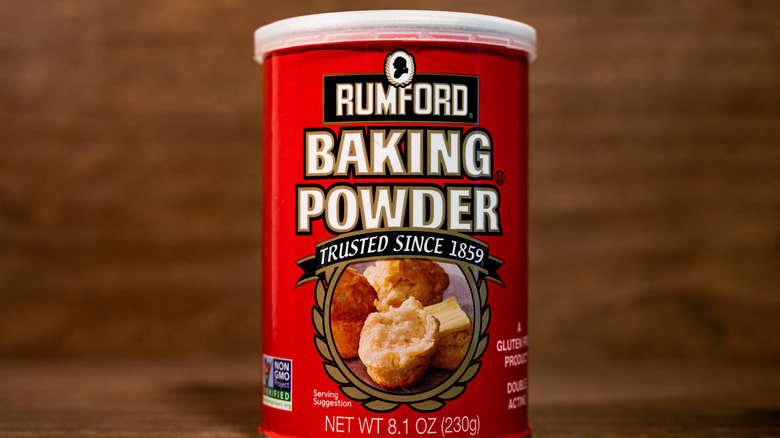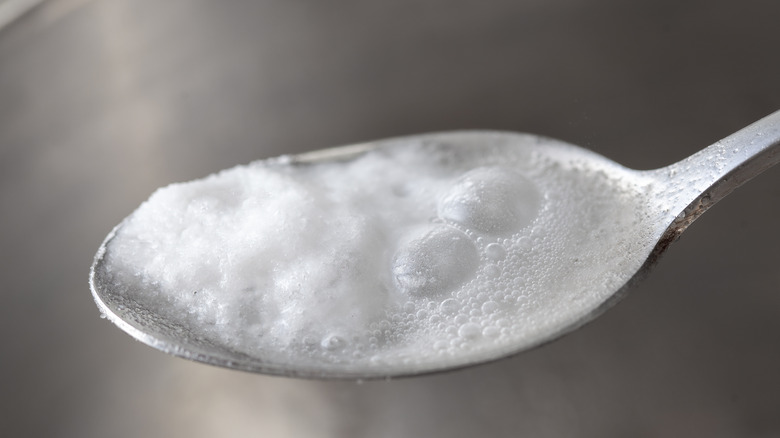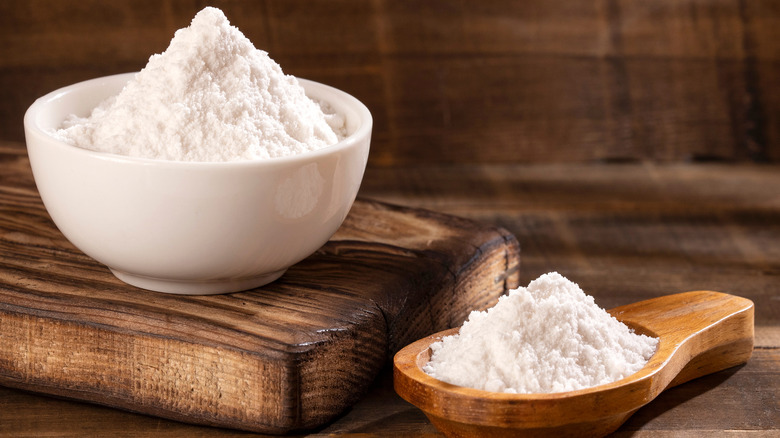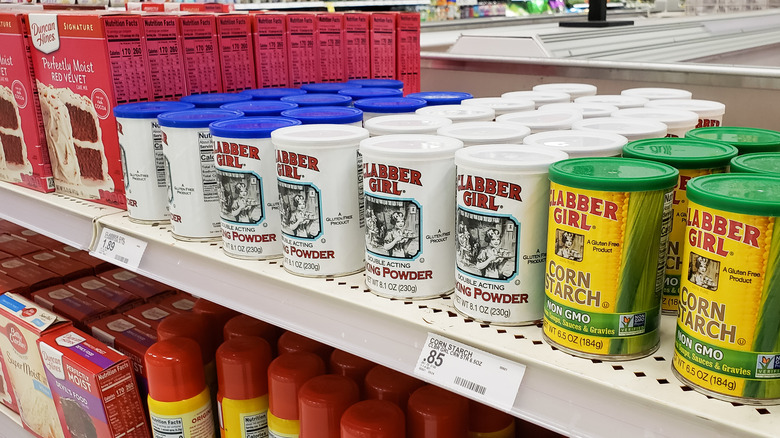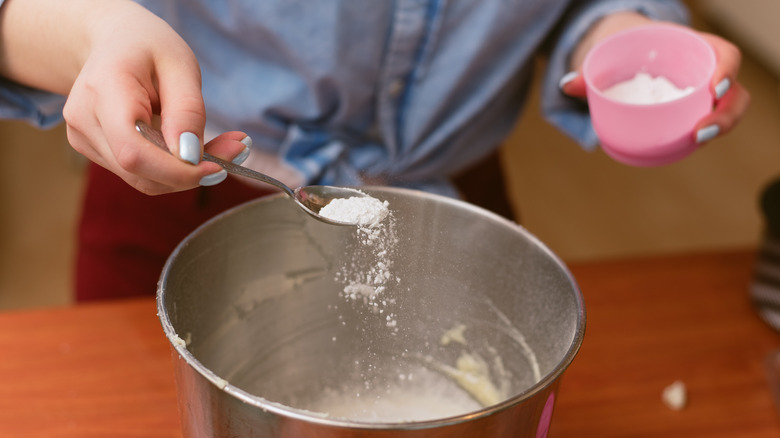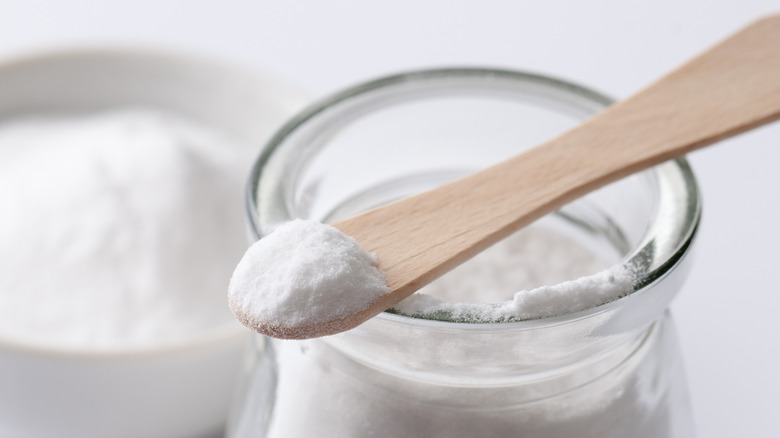What Is Baking Powder And How Should You Use It?
If you've ever baked a batch of sugar cookies, a birthday cake, a loaf of Irish soda bread, or other yummy baked goods, you've most likely reached for that little canister of baking powder. But have you ever wondered why recipes call for baking powder? Or if you can just substitute baking soda if that's all you have in your cupboard? It turns out it's worth knowing more about baking powder and exactly what it does for your baking.
Baking powder has been around since the mid-19th century, according to Smithsonian Magazine. Before then, getting baked goods to rise was a days-long and labor-intensive process, and it was no wonder that professional and home bakers alike wanted an easier way. It was the invention of baking powder by chemist Eben Norton Horsford in 1856 that really changed baking.
Horsford patented a combination of naturally occurring chemical compounds that gave cakes and other baked goods a light and airy texture, and was affordable for home bakers. That baking powder formula is the one we continue to use today. Horsford's company, Rumford Chemical Works, was named to honor noted scientist and inventor Benjamin Thompson — Count Rumford (according to the American Chemical Society) — and Rumford Baking Powder is still sold in stores.
Here's how baking powder works
The way baked goods rise is through leavening, which is when air or gas bubbles incorporated into doughs and batters expand during baking (via The Spruce Eats). Air can be whipped into batters by hand or with a mixer, and water trapped in mixtures can leaven foods as it turns to steam during baking. Yeast will leaven breads and cakes with bubbles of carbon dioxide gas, created by the living yeast organisms as they digest sugars in the mixture. Baking powder, a chemical leavener, also creates carbon dioxide bubbles, but much more quickly that yeast can.
Baking powder works because it contains two chemicals that react with one another: sodium bicarbonate (baking soda) and an acid like monocalcium phosphate or cream of tartar. Once the baking powder is exposed to moisture and heat, these chemicals react with each another and create carbon dioxide.
Sally's Baking Addiction says that most baking powder sold today is "double acting," which means it creates carbon dioxide bubbles twice. Baking powder activates for the first time when it's combined with liquids, like the wet ingredients in your recipe. It then activates a second time when exposed to heat — when you pop your batter or dough in the oven. That's two chances for baked treats to rise and become airy and light. The acid in baking powder also reduces the off flavors created by sodium bicarbonate.
Baking powder vs. baking soda
It's easy to confuse baking soda and baking powder. For one thing, these two baking additives look a lot alike: white and powdery. They also have similar jobs in baking as chemical leaveners, which Sally's Baking Addiction says is to help baked goods like cakes, cookies, and quick breads rise. They are, however, very different beasts, and understanding this is key to better baking results.
According to the blog The Bake School, baking soda is just one ingredient: Sodium bicarbonate. It won't do anything in baked goods unless there is an acid, such as buttermilk or sour cream, to activate it. Baking powder, on the other hand, is a mixture of baking soda plus one or more powdered acids. It's okay if there is no acid in the recipe, because baking powder has its own. Cornstarch is also blended into baking powder to prevent caking and to control any traces of moisture in the powder.
The Kitchn shares that while baking powder can be sold as slow or fast-acting, what's usually found on the store shelves is double-acting. This is the most popular type because it creates carbon dioxide twice, giving baked goods a reliable lift and better texture.
Where to buy baking powder
As the name suggests, if you're looking for baking powder at the store, a sure bet is to begin at the baking aisle. At your local market or grocery store, The Spruce Eats suggests looking for the aisle where other baking items like flour, sugar, and spices are sold. What's Cooking America says that popular brands of baking powder in the U.S. include Calumet, Clabber Girl, Rumford, and Davis. All of these brands are sold in small, cylindrical containers, which is one way to distinguish them from baking soda, which is most often sold in boxes. You can also buy baking powder online or in bulk.
Check the expiration date before buying your baking powder. Though there are some food expiration dates you can ignore, this isn't the case with baking powder. Old or expired baking powder in your recipes won't work as well, and might not work at all.
Store your baking powder in a dry, room-temperature location. What's Cooking America points out that moisture is what causes baking powder to lose its strength, so store it away from sinks and stoves, and never in the fridge.
How to use baking powder in recipes
Check your recipe for the amount of baking powder required. It's usually listed with the other dry ingredients like flour, cocoa powder, and salt in a recipe, like in a One Bowl Chocolate Cake recipe from Martha Stewart. Depending on the recipe, both baking powder and baking soda may be required, and it's important not to mix up the quantities for the two. To measure, Baking A Moment says to scoop baking powder into a measuring spoon, then draw a flat edge across the top to level it off.
If you're creating your own recipe and want to add baking powder, Sally's Baking Addiction says that for every cup of flour, add one teaspoon of baking powder. Because baking powder already contains acids to activate it, you can use baking powder in recipes that have no other acids. (Some examples of acidic ingredients include buttermilk, yogurt, cocoa powder, molasses, and lemon juice.) However, you can also use baking powder and an acidic ingredient in a recipe where you want the leavening action of baking powder and also some tang or sour flavor, such as with buttermilk pancakes or lemon-flavored baked goods (ia Sally's Baking Addiction).
No baking powder on hand? Use these substitutes
If you find you have no baking powder in the house, and have no time to run to the store, fortunately, you have options. The Kitchn says you can make your own baking powder. To do this, you need baking soda and some cream of tartar. Cream of tartar is another dry, white powder, created as a byproduct of wine making (via All Recipes). It's often used when whipping egg whites into meringues to help the peaks stay stable, and it's used to make chewy snickerdoodle cookies. Because recipes often call for only a pinch of cream of tartar, there's a chance you'll find a jar in your pantry, left over from another baking project. According to The Kitchn, to make homemade baking powder blend one tablespoon of baking soda with two tablespoons of cream of tartar.
You can also substitute baking soda for baking powder. Be careful, however; this requires some math and possibly a change to your recipe. Bon Appétit points out that because baking soda is four times as potent as baking powder, you should only use a quarter as much. And because baking soda needs an acid to activate it, your recipe will need to have some kind of acidic ingredient — or you can sub one in, such as using buttermilk in place of some or all of the regular milk.
